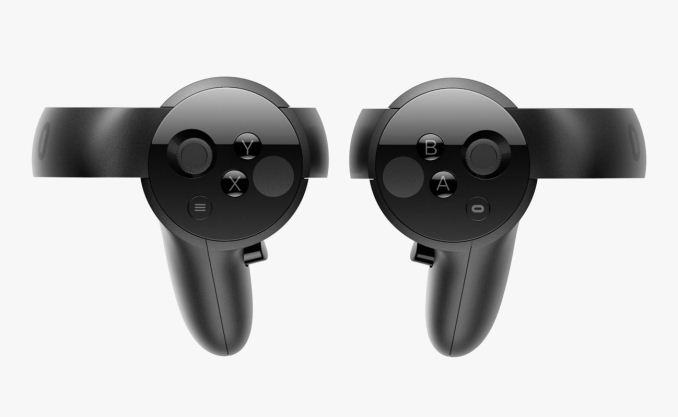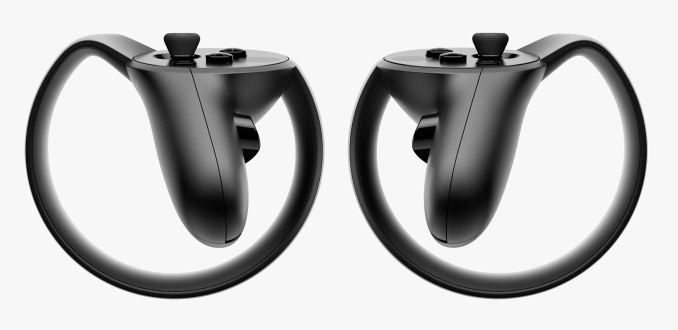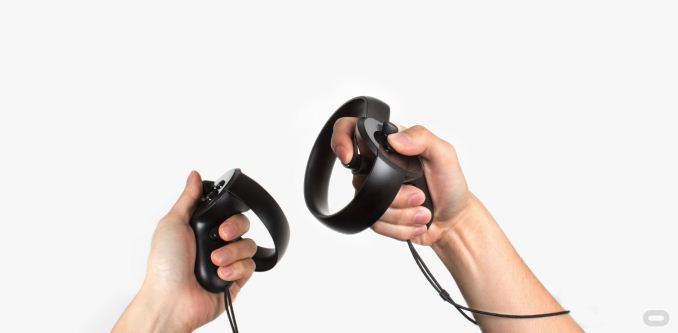Oculus Touch Controllers Shipping In December for $199
by Ryan Smith on October 6, 2016 6:40 PM EST- Posted in
- VR
- Oculus Rift
- Oculus

Back when the Oculus Rift and HTC Vive VR headsets launched earlier this year, one of the main differentiating features was the inclusion of touch/motion controllers. The Rift was launched with a focus on seated gaming, while Valve & HTC opted to focus on motion control and room scale gaming. As a result while the headsets were quite similar, their pack-in hardware was different; the Rift shipped with an Xbox One controller, while the Vive shipped with its two motion controllers and supporting Lighthouse sensor hardware. This also led to a notable difference in price, with the Rift launching at $599 while the Vive launched at $799, essentially putting a $200 price tag on motion controls.
However even before the Rift launched, Oculus already had plans in the works for their own motion controls. Dubbed the Oculus Touch, the handheld sensors and supporting hardware wouldn’t be ready for the launch, but instead would be launching as an add-on to the Rift later this year. Now at Oculus’s latest Connect event, we finally have the full details on the Oculus Touch launch, and how the system will work.
The Oculus Touch controllers will be hitting the market right before Christmas, shipping in volume on December 6th, while preorders are starting on Monday, October 10th. The Touch kit, which includes the two controllers, two pack-in games – VR Sports Challenge and The Unspoken – and one extra camera (or as Oculus calls it, the constellation sensor) will sell for $199. Given that this has long been the assumed price of the Oculus Touch kit, there shouldn’t be any surprises here.
With that said, Rift owners looking to do room scale gaming will want to pay attention to the technical details here, as they matter quite a bit. As Oculus notes, even though the second camera improves the system’s ability to track the headset and controllers, unlike the Vive’s Lighthouse system, two cameras won’t be enough for room scale. The experience you get out of the box with the Oculus Touch system will depend on how you position the cameras – there are multiple options available – but even in a diagonal setup for 360 degree tracking, the play area won’t be large enough to be room scale as defined by the Vive. Instead, for true room scale gaming a 3rd camera is required, which Oculus will sell separately for $79, bringing the price of a complete headset and room scale kit up to $879.
Given what’s known about Oculus’s constellation system, that they can’t pull off room scale with only two cameras isn’t too surprising; the cameras just don’t have the right combination of FOV and range to do it with two. To that end, launching the Touch with only one extra camera seems to be a calculated risk, with Oculus betting that most users are primarily after motion controls will be fine with gaming on a smaller scale – on the order of a few feet by a few feet – as we experienced first-hand with the prototype Touch hardware back in March. Otherwise true room scale can be done thanks to the third camera, albeit at an additional price.
Finally, along with today’s launch reveal, Oculus has also confirmed that 35 games will be Touch-enabled in time for the hardware’s launch in December. On a personal note, I’m interested in seeing what the end-user feedback is on the Touch controllers. Oculus has gone in a very different direction than HTC/Valve on the form factor of the controllers – using what amounts to two halves of a gamepad instead of two wands – so I’m curious to see how that compares to the wands over long-term use. The Vive system essentially senses the end of the wand, whereas the Oculus system needs to sense the markers wrapped around the hands, so it’s a small but potentially important difference in how user interaction will work and feel.
Source: Oculus












14 Comments
View All Comments
austinsguitar - Thursday, October 6, 2016 - link
i'm going to say this and a lot of others will comment.THIS........PRICE.......IS......NOT........OKAY.
comment below.
austinsguitar - Thursday, October 6, 2016 - link
oh my bad. i just got back from walmart with my 32 inch 4k smart tv for 220.:^)
frenchy_2001 - Friday, October 7, 2016 - link
if only... If you know of any 32" 4k TV, I'm interested, but so far, this is an elusive beast.SirMaster - Thursday, October 6, 2016 - link
Why is it not OK?2 controllers (130/ea) and another tracking unit ($135) would cost $395 from HTC.
Also the Rift plus Touch cost the same as the Vive and both offer about the same abilities then.
$200 seemed like the natural choice to me.
trulyuncouth - Thursday, October 6, 2016 - link
Its the same price to just get stand in place 360 and will require you to put two cameras atleast 3 feet away on opposing sides of you. It is an extra $100 above the Vive if you want what they are calling roomscale. It will end up in a considerably smaller space that you can move around in, but a bit better occlusion resistance in that smaller space.Ultimately Rift will continue to be really for sim-gamer's only(or people who are okay with tacked on VR camera in a 3rd person game). People who want to stand up and move around with hands in a game are best served by vive. I own both, and can only suggest the rift if you have zero space to move and want to save $200 or if your favorite racing game is rift-only ATM.
Oh, and definitely check them out in person first, the rift has less stereo overlap and has a bit of distortion as you turn your head. The Vive has a bit less pixel density but higher FOV, brightness, better stereo and no distortion.
trulyuncouth - Thursday, October 6, 2016 - link
Oh, and on the cost of buying the pieces ala carte from HTC, Oculus actually doesn't offer any extra parts for sale so we don't know what the prices would be for individual parts. They actually offer no replacements and won't even repair damaged headsets in most locales, they just expect people to buy an entire new headset if they decline a warranty repair.HTC's prices are pretty bad, but there is no comparison at this point.
ChefJeff789 - Thursday, October 6, 2016 - link
Selling them separately is helping nobody. Some games will support the touch. Some games will even require (or at least suggest) the use of the additional camera. I don't want to keep track of the extra crap I need to play something, I just want to buy one system and play everything made for it. Fragmentation is stupid, and can only be successful when you have products in high demand.Ryan Smith - Thursday, October 6, 2016 - link
For what it's worth, Oculus is also launching a new $798 bundle that includes the Rift package and the Touch package together.trulyuncouth - Thursday, October 6, 2016 - link
Its too late for that to stop the problem. They have heavily fractured their market, I'd be very interested to see their attachment rate for the headsets they've already sold once touch comes out.Manch - Friday, October 7, 2016 - link
Agree. Oculus hurt themselves by fracturing their market when they launched an incomplete product. By incomplete I mean comparatively to the HTC Vive. They could mitigate this by putting two cameras in there to create parity with HTC's offering and giving a discount to early adopters for the touch package. Usually though as we've seen with other add-ons, if it's not part of the initial package, then odds are it will go the way of the dodo. Of course if adoption numbers of the Rift with the touch package far outpace the headset only crowd then developers may be more inclined to develop with the controllers in mind. Pack in doesn't guarantee anything though. If the controllers are no good then developers wont use them. XBOX one is a good example of a pack in that went nowhere. Kinect is all but useless and definitely not desired by many.